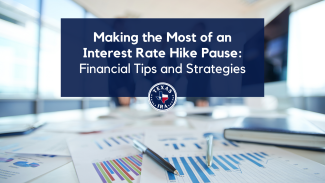
Making the Most of an Interest Rate Hike Pause: Financial Tips and Strategies
In times of market volatility, when inflation is increasing, the Federal Reserve will raise interest rates to help to cool the inflation spike. During this period, people are anxious and keep a tight grip on their wallets. In time, the Fed can put a halt on the interest rate hike. This pause is a breath of fresh air for consumers to take advantage of the extra money in their pockets by creating short-term strategies, which may include:
Paying down bad debt
Do you have debt hanging over your head, and each month, all you have been able to pay is the minimum? With interest rates paused, take some of the extra money you will be saving, put it toward credit card balances or those loans with higher interest rates, and work to eliminate them. Clearing off debt is a great motivator and helps alleviate some of life's stresses. A few options to consider include:
- Debt snowball – Making minimum payments on the debts and paying off the smallest debts before tackling the larger balances.
- Debt avalanche – Making the minimum payments on all debt and using any extra money to pay off the debt with the highest interest rate.
Investing in low-risk securities
Now is a great time to consider taking the extra money you will save as inflation cools and the interest rate is no longer being driven up and investing some in low-risk securities. Remember, money has a way of accumulating over time, and you don't have to invest large sums all at once. Twenty dollars here and fifty dollars there has the potential to grow if given the chance. A few low-risk securities to consider are:
- High-yield savings accounts
- Certificate of deposits (CDs)
- Treasury Bills
- Mutual funds
It is critical to keep in mind that all investments involve risk, and you should learn about how potential downsides to any investment could impact your financial goals.
Starting an emergency fund
The emergency fund is one of financial planning's more critical and less glamorous features. Generally, it is recommended that you save up at least 3-6 months of cash and keep it in an account that you can access quickly and easily if necessary. This could help keep you from building up credit card debt or having to pursue a high-interest personal loan.
Reviewing your expenses and revise your budget
Take the time to conduct a comprehensive review of your expenses versus your income. Understand how you are spending your money. Is there anything you can cut back on? A budget can help you manage your day-to-day finances and provide a foundation for designing a long-term strategy and creating attainable financial goals. A few things to consider when budgeting:
- Be flexible – Every month is a little bit different. Expenses can pop up, and you have to be prepared if such an issue occurs, whether responsibilities with the kids for school, events for family or friends, emergencies around the house, or with the car.
- Prioritize your payments – Don’t just blindly pay bills. Prioritize your payments, focus on the debt weighing you down the most, and get on top of it.
- Have someone help you – If you are in a relationship, both parties should be involved in the budgeting. If you are single, consider reaching out to a financial professional to work with you. Having someone else helping to monitor your finances may be beneficial to keep money from slipping through the cracks that could be used for more productive purposes.
Consulting your financial professional
As you begin to manage your money and contribute more now that interest rates are paused, consider getting the help you need from a financial professional who can guide you through the maze of prioritizing your costs, pinpointing the most effective investment strategies, determining which accounts would work for you, and trying to mitigate potential risk.
Take the time to schedule an appointment to consult a financial professional instead of trying to do it all on your own. Finance can be incredibly complex, even at the personal level, and what might seem like a small decision could have a significant impact, so make the call today to ensure your goals and strategy align.
Important Disclosures:
The opinions voiced in this material are for general information only and are not intended to provide specific advice or recommendations for any individual. To determine which investment(s) may be appropriate for you, consult your financial professional prior to investing.
Investing involves risks including possible loss of principal. No investment strategy or risk management technique can guarantee return or eliminate risk in all market environments.
All information is believed to be from reliable sources; however, LPL Financial makes no representation as to its completeness or accuracy.
Sources:
With rate hikes likely done, Fed turns to timing of cuts | Reuters
The Federal Reserve Didn’t Raise Rates: Take These 11 Steps Now | Bankrate
Debt Avalanche vs. Debt Snowball: What's the Difference? (investopedia.com)
This article was prepared by LPL Marketing Solutions
LPL Tracking # 519916

